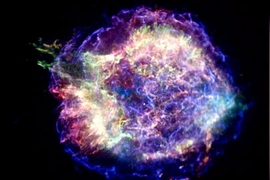MIT astronomers and a colleague have created an extraordinarily detailed image of the remains of an exploded star that provides new clues about the origins of cosmic rays, mysterious high-energy particles that bombard the Earth.
Using NASA's Chandra X-ray Observatory, the scientists mapped the rate of acceleration of cosmic ray electrons in a remnant of an exploded star, or supernova. The new map, the first of its kind, shows that the electrons are being accelerated at close to the theoretical maximum rate. This is compelling evidence that cosmic rays are created within supernova remnants.
The map was created from an image of Cassiopeia A, a 325-year-old supernova remnant. Blue, wispy arcs in the image trace the expanding outer shock wave where the acceleration takes place. The other colors in the image show debris from the explosion that has been heated to millions of degrees.
"Scientists have theorized since the 1960s that cosmic rays must be created in the tangle of magnetic fields at the shock (front), but here we can see this happening directly," said Michael Stage (Ph.D. 2003), who began the work as a postdoctoral associate at the MIT Kavli Institute for Astrophysics and Space and is now at the University of Massachusetts at Amherst.
"Explaining where cosmic rays come from helps us to understand other mysterious phenomena in the high-energy universe," such as the extragalactic jets thousands of light years in length produced by super-massive black holes, he said.
Scientists had previously developed a theory to explain how charged particles can be accelerated to extremely high energies--traveling at almost the speed of light--by bouncing back and forth across a shock wave many times.
"The electrons pick up speed each time they bounce across the shock front, like they're in a relativistic pinball machine," said team member Glenn Allen, a Kavli research scientist. "The magnetic fields are like the bumpers, and the shock is like a flipper."
In their analysis of the huge data set, the team was able to separate the X-rays coming from the accelerating electrons from those coming from the heated stellar debris.
"It's exciting to see regions where the glow produced by cosmic rays actually outshines the 10-million-degree gas heated by the supernova's shock waves," said John Houck, also a Kavli research scientist. "This helps us understand not only how cosmic rays are accelerated, but also how supernova remnants evolve."
The work was reported in the September issue of Nature Physics.
NASA's Marshall Space Flight Center in Huntsville, Ala., manages the Chandra program for the agency's Science Mission Directorate. The Smithsonian Astrophysical Observatory controls science and flight operations from the Chandra X-ray Center in Cambridge, Mass.
A version of this article appeared in MIT Tech Talk on November 22, 2006 (download PDF).







